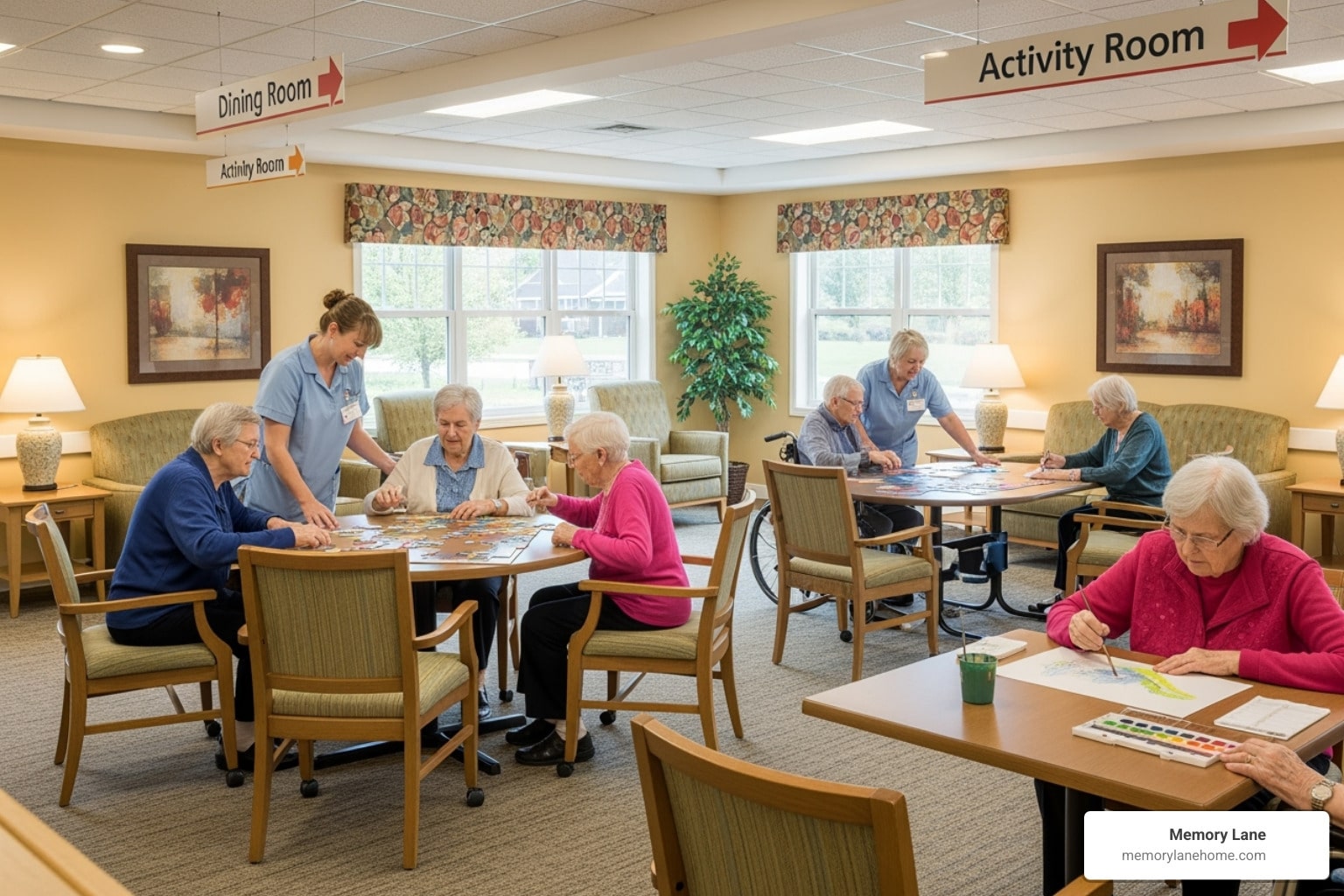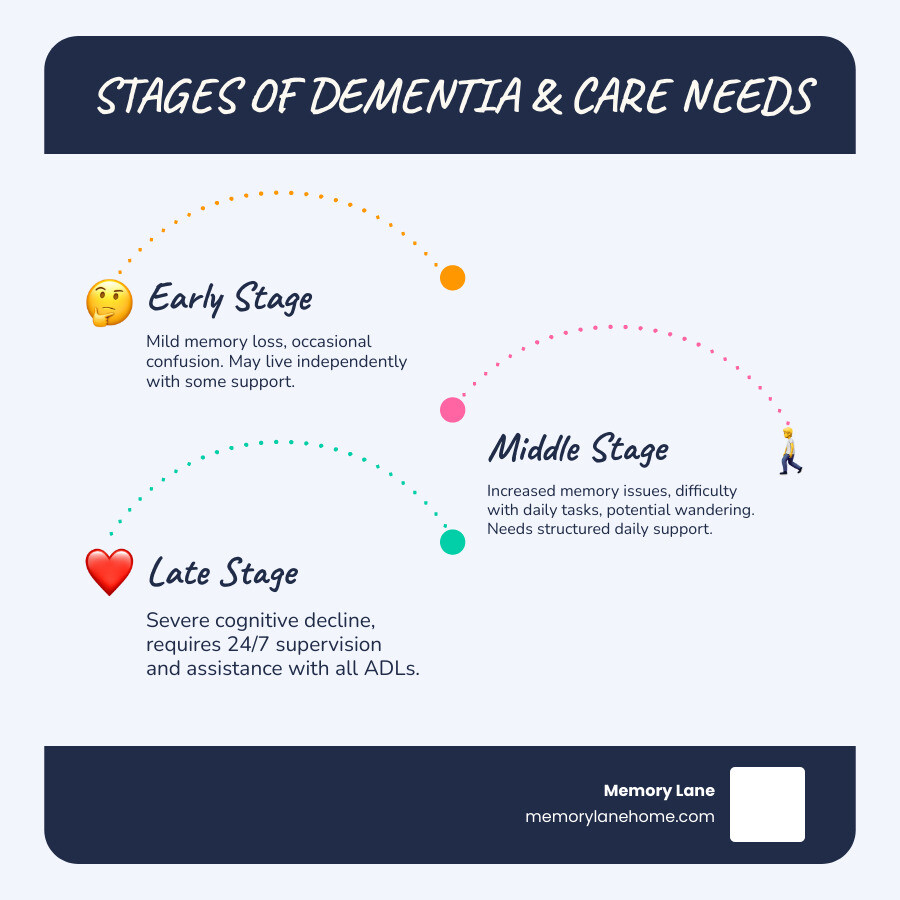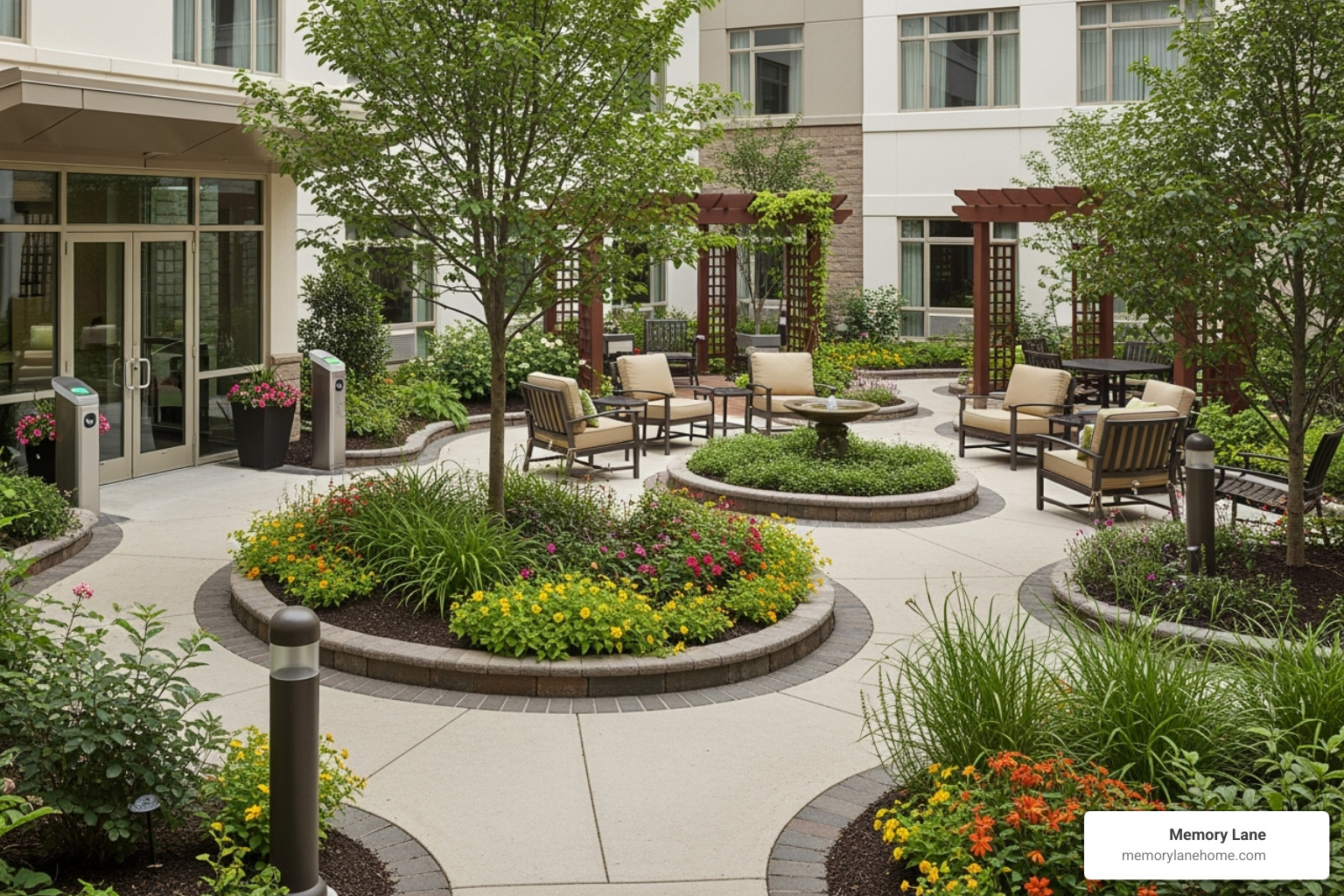
Memory Lane Ahead: What You Need to Know About Long-Term Care
Long Term Memory Care: Safe & Essential 2025
Understanding Your Options for Long-Term Memory Care
Long term memory care is specialized residential care for individuals living with Alzheimer’s disease, dementia, and other cognitive impairments. It provides 24/7 supervision, personalized support, and a secure environment custom to the unique needs of people experiencing memory loss.
Key things to know about long term memory care:
- Who it’s for: Individuals with Alzheimer’s, dementia, or other forms of cognitive decline needing specialized support.
- What it offers: 24/7 supervision, help with daily activities, medication management, memory-stimulating activities, and a secure environment.
- Where it’s provided: Specialized units in assisted living facilities, dedicated memory care communities, or nursing homes.
- Cost range: Typically $4,000-$7,000+ per month in the U.S., with significant state-to-state variation.
- Key difference from other care: Higher staff-to-resident ratios, specialized dementia training, and secure facilities to prevent wandering.
It can be difficult to learn that a loved one needs more support than you can provide at home. You might be noticing signs like increased confusion, safety concerns, or behavioral changes that make daily life challenging. The decision to explore long term memory care isn’t about giving up—it’s about finding the right level of specialized support to improve your loved one’s quality of life while giving you peace of mind. Dementia affects approximately 24 million people worldwide, with 1 in 10 people older than 65 experiencing some form of memory impairment.
I’m Jason Setsuda, a Board Certified Emergency Medicine Physician with over 10 years of medical experience and CFO of Memory Lane Assisted Living. Through my work, I’ve seen how the right long term memory care environment can dramatically improve both resident well-being and family confidence. Let me walk you through what you need to know to make an informed choice.

Understanding Memory Care and Senior Living
When a loved one shows signs of memory loss or receives a dementia diagnosis, you face unexpected questions about their care, safety, and future. Long term memory care is a specialized approach designed for people with cognitive impairments, where trained professionals provide support in a safe, purposeful environment.
The difference between memory care and other senior living options lies in the environment, staff, and level of care. Assisted living is for seniors who need help with daily tasks but are mostly independent. Nursing homes focus on complex medical care and rehabilitation. Memory care is purpose-built for cognitive decline, with environments designed to reduce confusion, staff who receive specialized dementia training, and activities crafted to engage the mind.
| Feature | Memory Care | Assisted Living | Nursing Home |
|---|---|---|---|
| Services | 24/7 supervision, ADL assistance, medication management, specialized dementia programs, behavioral support | ADL assistance, medication reminders, meals, social activities | 24/7 skilled nursing care, ADL assistance, medical treatments, rehabilitation |
| Environment | Secure, easy-to-steer, wander-controlled, sensory-friendly | Residential, non-secure, emphasis on independence | Clinical, medical equipment, often less homelike |
| Staffing | Higher staff-to-resident ratio, specialized dementia training | General caregivers, some medical staff, less specialized dementia training | Licensed nurses, therapists, certified nursing assistants |
| Resident Profile | Mid-to-late stage dementia, cognitive impairments, wandering risk | Independent with some ADL needs, minimal cognitive decline | Complex medical needs, severe physical limitations, some with dementia |
Key Features of the Memory Lane Environment and Team
At Memory Lane, our communities are intentionally designed to feel calming and easy to steer, not institutional. Our secure facilities feature easy-to-steer layouts that reduce anxiety, while secured entrances and wander management systems prevent residents from wandering into unsafe situations. This gives families peace of mind while preserving residents’ sense of freedom.
Our team is our greatest asset. We maintain a higher staff-to-resident ratio than typical assisted living, allowing for more one-on-one attention. Every team member completes specialized dementia training to learn compassionate communication and behavior redirection techniques. We accept a person-centered care approach, focusing on each resident’s life history, preferences, and what brings them joy. This helps preserve their identity and sense of self.
Who Benefits Most from Memory Care?
The need for memory care is often signaled by practical, immediate concerns. It’s for individuals with various forms of dementia, including Alzheimer’s disease, Lewy body dementia, and frontotemporal dementia, but the timing depends on specific challenges.
Safety concerns at home are a major tipping point. This includes wandering, forgetting to turn off appliances, or frequent falls. When someone needs 24/7 supervision to stay safe, professional care becomes necessary. Caregiver stress and burnout are also critical signs; recognizing your own limits is an act of wisdom, not failure. Other indicators include neglect of personal hygiene, poor nutrition, and significant behavioral changes like increased agitation or aggression, which are often managed more effectively by trained staff.
Memory care as a senior living option provides a crucial bridge when home care is no longer safe or sustainable, offering peace of mind to both the resident and their family.
Key Services and Benefits of Specialized Memory Care
Choosing long term memory care at Memory Lane means selecting a holistic approach that supports every aspect of your loved one’s daily life.
Our staff provides compassionate assistance with Activities of Daily Living (ADLs), such as bathing, dressing, grooming, and eating, always approaching these personal moments with dignity and respect. Medication management is another cornerstone of our care, where our trained staff oversee schedules to ensure safety and accuracy, removing a significant worry for families.
Every resident has a personalized care plan developed with family and healthcare providers, which we adjust as needs change. This responsive approach ensures the right level of support is always provided. We also use structured routines to create a predictable and comforting daily rhythm, which reduces anxiety and helps residents feel more secure. A key focus is on socialization and cognitive engagement, as isolation can accelerate cognitive decline. Our communities are vibrant, connected places that foster a sense of belonging.
Programs and Activities that Improve Quality of Life
Activities at Memory Lane are therapeutic tools designed to slow cognitive decline and improve well-being. Our programs are backed by research showing that combining physical and cognitive exercise can improve brain function.
- Memory-Stimulating Activities: Cognitive games, puzzles, and reminiscence therapy help activate the brain and provide a sense of purpose.
- Art and Music Therapy: These programs offer non-verbal ways for residents to express themselves, reduce stress, and connect with powerful memories. Research on neurologic music therapy shows it can significantly improve executive function.
- Reminiscence Therapy: Using photos and props, we help residents revisit positive life experiences, validating their life stories and reinforcing their identity.
- Physical and Sensory Activities: Light physical exercise like chair yoga improves balance and mood. Gardening and sensory stimulation activities (aromatherapy, tactile experiences) offer calming and grounding experiences.
These programs are integral to our person-centered care, helping residents maintain function, reduce agitation, and experience genuine joy.
Ensuring Resident Safety and Security

At Memory Lane, we create a safe environment that preserves dignity and freedom. Our 24/7 supervision means trained staff are always present and ready to respond. We use secured entrances and exits and discreet wander management systems to prevent residents from leaving unsupervised while allowing them to move freely within the community.
Emergency call systems in all rooms provide a direct line to staff. Our enclosed outdoor courtyards allow residents to enjoy fresh air and nature safely. Fall prevention is integrated into our facility design and staff training, with clear pathways, grab bars, and proactive assistance. For more on reducing fall risks, the CDC offers valuable resources. By combining thoughtful design, technology, and vigilant staffing, we provide an environment where residents live safely and families find peace of mind.
Navigating the Transition to Long Term Memory Care
The decision to move a loved one into long term memory care is an emotional one, often accompanied by feelings of guilt, sadness, and relief. Please know that seeking specialized care is not giving up; it’s an act of love that prioritizes your loved one’s safety and quality of life when their needs have evolved beyond what can be managed at home.
At Memory Lane, we understand this transition affects the whole family. We make family involvement a priority, learning your loved one’s life story to create a personalized experience. Your role will shift from being a hands-on caregiver to an advocate and loving presence, allowing you to focus on quality time together. Planning the move carefully can ease the transition. We help families create a plan that includes bringing personal items like a favorite blanket or familiar photos to make the new room feel like home.
We also provide caregiver support and resources to help you steer this journey. Connecting with others who understand what you’re going through can be a great source of comfort.
Signs It Might Be Time for Memory Care
Knowing when to make the move isn’t always clear, but certain signs indicate that home care has become unsafe or unsustainable.
- Safety risks at home: This is often the tipping point. Look for wandering, forgetting to turn off appliances, medication errors, or frequent falls.
- Changes in behavior and mood: Increased anxiety, agitation, or aggression can signal that the current environment is no longer meeting their needs.
- Neglected personal hygiene: Forgetting to bathe, wearing the same clothes for days, or a decline in grooming are signs that daily support is needed.
- Wandering: This is one of the most dangerous dementia-related behaviors. A secure environment is essential to prevent someone from getting lost.
- Increased caregiver burnout: If you are exhausted, anxious, or your own health is declining, it’s a sign that you need more support. You cannot pour from an empty cup.
- Decline in health: Unexplained weight loss, inability to manage meals, or difficulty managing the household are also indicators that professional care is necessary.
What to Look for in a Long Term Memory Care Facility
Choosing the right facility requires careful research and trusting your instincts. When you visit, focus on these key areas:
- Staff Interaction: Do staff members treat residents with respect, warmth, and patience? Do they seem genuinely engaged?
- Staff Qualifications: Ask about specific dementia care training, continuing education, and the availability of licensed nurses.
- Staff-to-Resident Ratio: A higher ratio means more personalized attention. Ask about staffing levels on all shifts, including overnight.
- Cleanliness and Environment: The community should be clean, well-maintained, and feel homelike, not institutional. The atmosphere should be warm and welcoming.
- Meal Quality: Ask to see a menu and inquire about accommodations for special diets. Observe a mealtime if possible to see if it’s a calm, supportive experience.
- Communication with Families: How does the facility keep you informed? Is there an open-door policy for visits? Regular, transparent communication is key.
- Programs and Activities: Look for a varied schedule of engaging, memory-stimulating activities that bring joy and purpose.
- Safety and Security: Verify that entrances are secured, there are safe outdoor spaces, and clear emergency procedures are in place.
For additional guidance, the National Institute on Aging offers helpful resources on Alzheimer’s Caregiving: Finding Long-Term Care.
The Financial Side of Memory Care
Understanding the financial side of long term memory care is a critical step in the planning process. Costs can be significant, and you deserve transparency about expenses and payment options.
Memory care pricing reflects its specialized environment, higher staffing ratios, and dementia-specific programming. Costs vary based on geographic location, room type (private vs. semi-private), and the specific services included in the base price.
Understanding the Costs of Long Term Memory Care
What does long term memory care actually cost? According to the Alzheimer’s Association, the average annual cost in a U.S. nursing home is $116,800 for a private room and $104,025 for a semi-private room. This breaks down to a monthly range of $4,000 to $7,000 across the U.S., though this can be higher or lower depending on location and services.
When evaluating costs, ask for a detailed breakdown of what’s included. Most facilities bundle ADL assistance, meals, medication management, and activities into a base rate, but some may charge extra for specialized therapies or transportation. The level of care an individual needs can also influence the final price.
Financial Assistance and Payment Options
Several options can help families manage the cost of long term memory care.
- Personal Funds: Savings, pensions, and Social Security benefits are the foundation for many families’ payment plans.
- Long-Term Care Insurance: If your loved one has a policy, it can be a major help. Review the policy’s daily benefit limits, waiting periods, and covered services early in your search.
- Medicare and Medicaid: It’s important to know that Medicare generally does not cover long-term custodial care. It is designed for short-term skilled nursing. Medicaid, a joint federal and state program, can cover long-term care for those who meet strict income and asset requirements. Eligibility varies by state, so check your local guidelines.
- Veterans Benefits: Veterans or their surviving spouses may qualify for VA benefits like the Aid and Attendance benefit, which provides additional monthly income to help cover care costs.
- Other Options: Some families use life insurance policy conversions, accelerated death benefits, or specialized annuities to fund care.
We recommend consulting a financial advisor specializing in elder care to steer these options. For more information, the government provides helpful resources at LongTermCare.gov. At Memory Lane, we are committed to helping you understand the financial side as clearly as possible.
Frequently Asked Questions about Memory Care
As you consider long term memory care, you likely have many questions. Here are answers to some of the most common ones we hear from families.
How do facilities support families and caregivers?
At Memory Lane, we know our role extends to supporting the entire family. One of the most immediate benefits is respite, allowing you to rest and recharge, knowing your loved one is safe. You can transition from being a full-time caregiver back to being a daughter, son, or spouse, focusing on quality time together.
We maintain open communication channels with regular updates and are always available to answer your questions. Through regular care plan meetings, you remain a vital partner in your loved one’s care. We also provide educational resources and can connect you with support groups where you can share experiences with other families on a similar journey. This partnership is central to the peace of mind we strive to create.
What role does innovation play in modern memory care?
Long term memory care is constantly evolving. At Memory Lane, we incorporate evidence-based practices to improve quality of life.
- Research-Based Programs: We integrate findings from studies showing that combined physical and cognitive activities can improve brain function. Our programming is designed to be both engaging and therapeutic.
- Technology for Engagement: We use tools like cognitive fitness apps and have seen remarkable results with neurologic music therapy, which can improve cognitive task completion and reach people when words fail.
- Person-Centered Care Model: This is perhaps the most important innovation. We focus on each person’s unique life story, preferences, and joys. This approach honors their identity beyond their diagnosis.
- Environmental Design: Our facility layouts, color choices, and lighting are all informed by research on how to create spaces that reduce confusion and anxiety for people with dementia.
Innovation for us means continuously learning and applying better ways to support the people in our care.
How do I prepare my loved one for the move?
Preparing for a move to long term memory care can be made smoother with thoughtful planning.
If possible, involve them in the process. Touring facilities together or letting them choose items for their room can provide a sense of control. Personalizing their new room with familiar items like photos, a favorite chair, or a cherished blanket is crucial for creating a sense of continuity and comfort.
Plan moving day carefully to reduce stress. Consider setting up the room first so your loved one walks into a space that already feels like theirs. Communicate with facility staff by sharing your loved one’s life story, preferences, and routines. This helps our team provide truly personalized care from day one.
Finally, acknowledge all emotions—yours and theirs. Reassure them of your love and continued presence. After the move, maintain familiar routines, like visiting at consistent times, to provide stability. The adjustment period varies, but your patience and advocacy are essential. For more guidance, visit the National Institute on Aging’s resource on Alzheimer’s Caregiving: Finding Long-Term Care.
Conclusion
Choosing long term memory care is a profound decision, but it’s one you don’t have to make alone. It is not about giving up; it’s about giving your loved one the specialized support they need to live with dignity and purpose, while also allowing you to be a family member again, not just a caregiver.
At Memory Lane, we believe every person living with dementia deserves to thrive. Our communities are built on this principle, with a compassionate team, a higher staff-to-resident ratio, and engaging, person-centered programming. We provide a secure environment where residents can live safely and families can find peace of mind.
Making an informed choice means looking at staff quality, safety, activities, and the overall environment. It means trusting your instincts. If a place feels warm, engaging, and safe, you are on the right track.
If you’re in the Detroit area, we invite you to visit Memory Lane in Ann Arbor, Ypsilanti, or Saline. Meet our team, see our community, and ask all your questions. Let us show you if we are the right fit for your family’s journey.
Explore our assisted living and memory care community in Detroit
We are here to support you every step of the way.